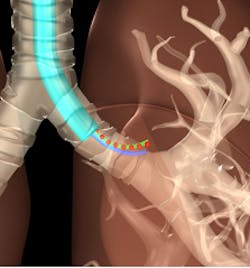New software keeps X-ray exposure down
Researchers fromNorth Carolina State University (Raleigh, NC, USA) and the University of North Carolina at Chapel Hill (UNC; Chapel Hill, NC, USA) have developed an algorithm to help surgeons use X-rays to track devices used in minimally invasive surgical procedures while limiting the patient's exposure to radiation from the X-rays.
Many surgical procedures now use long, thin devices -- such as "steerable needles" -- that can be inserted into a patient's body through a small incision and then steered to a target location. These minimally invasive procedures allow doctors to perform surgeries without having to make major incisions, which decreases the risk of infection and shortens the patient's recovery time.
However, these techniques pose a challenge to surgeons, because it is difficult for them to determine precisely where the surgical device is in the patient's body.
One solution to the problem is to use X-rays to track the progress of the surgical device in the patient. But doctors want to minimize the number of X-rays taken, to limit the patient's exposure to radiation.
"We have now developed a computer algorithm to determine the fewest number of X-rays that need to be taken, as well as what angles they need to be taken from, in order to give surgeons the information they need on a surgical device's location in the body," says Dr. Edgar Lobaton, an assistant professor of electrical and computer engineering at NC State.
The new software allows surgeons to enter what type of procedure they will be performing and how precise they need the location data to be. Those variables are then plugged into the algorithm developed by the research team, which tells the surgeon how many X-rays will be needed -- and from which angles -- to produce the necessary details.
For example, if a surgeon needs only a fairly general idea of where a device is located, only two or three X-rays may be needed -- whereas more X-rays would be required if the surgeon needs extremely precise location data.
A paper by the researchers entitled "Continuous Shape Estimation of Continuum Robots Using X-ray Images," will be presented at the IEEE International Conference on Robotics and Automation, being held in Karlsruhe, Germany between May 6-10.
The paper was co-authored by Jingua Fu, a former graduate student at UNC, Luis Torres, a PhD student at UNC and Dr. Ron Alterovitz, an assistant professor of computer science at UNC.
The research was supported by the National Science Foundation and the National Institutes of Health.
Related items from Vision Systems Design that you might also find of interest.
1.Hand held instrument inspects the retina
Medical technology firm Lumetrics (Rochester, NY, USA) has won a $973,000 grant from the National Institutes of Health (Bethseda, MD, USA) to fund the development of a digital hand-held diagnostic ophthalmic instrument for inspecting the human retina.
2.UK researchers to shrink MRI system
A new system that enables medical personnel to image difficult areas of the body is being developed by researchers at Imperial College London (London, UK).
3.Researchers turn an iPhone into an otoscope
A pediatric medical device being developed at Georgia Tech (Atlanta, GA, USA) and Emory University (Atlanta, GA, USA) could make life easier for parents with children suffering from an ear infection.
-- Dave Wilson, Senior Editor,Vision Systems Design
